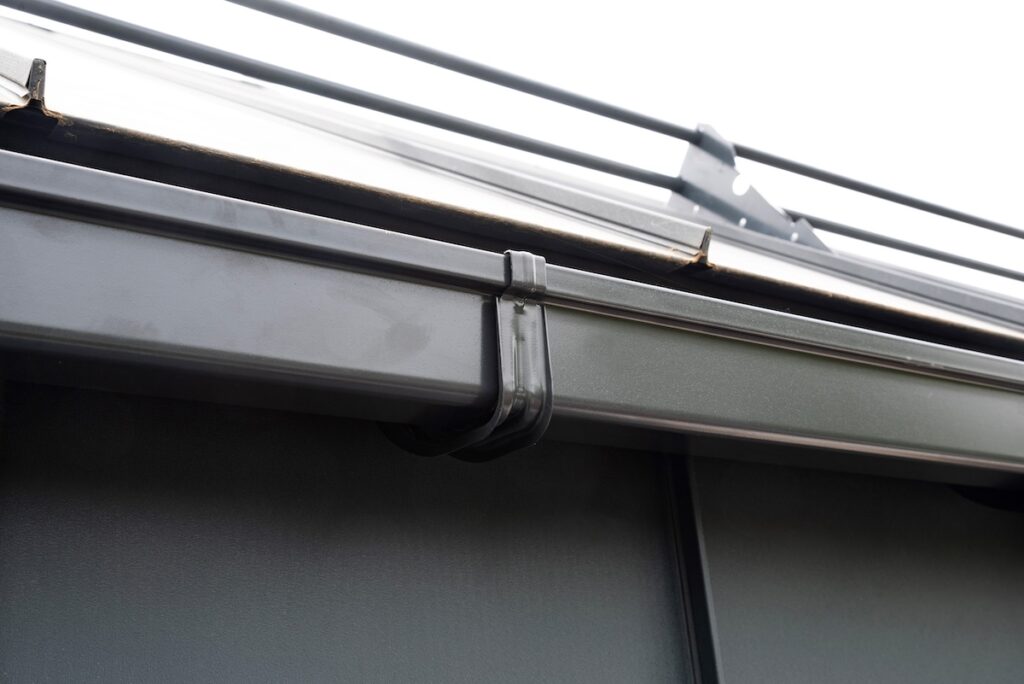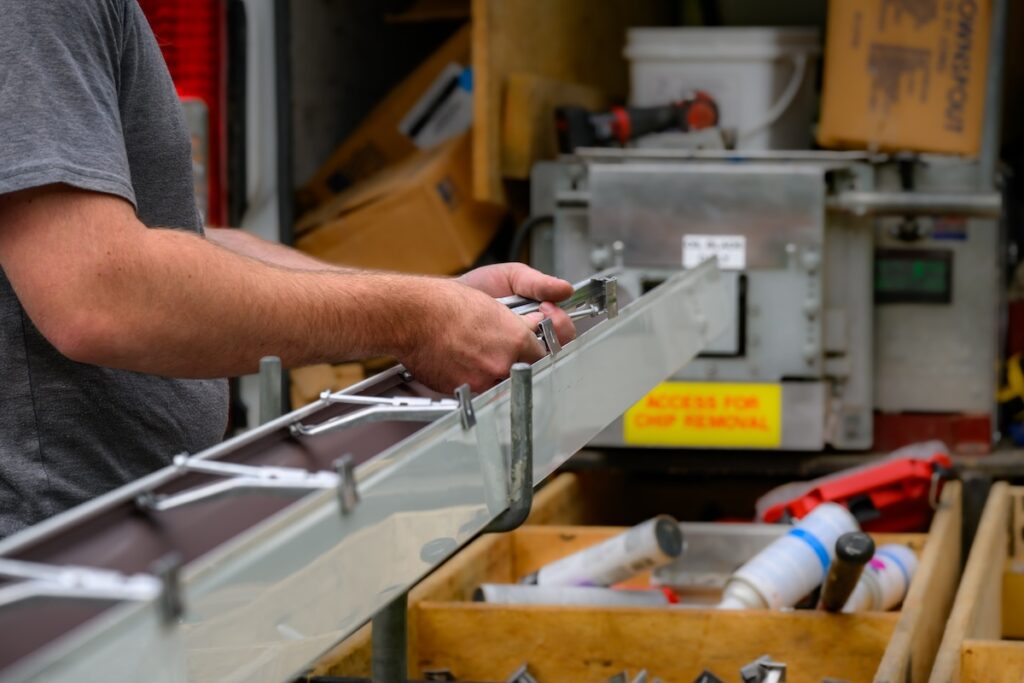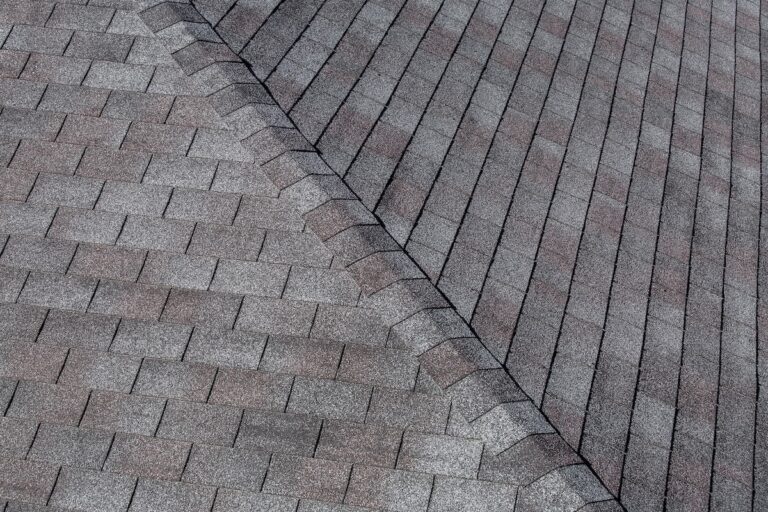Box gutters are a unique style of rainwater drainage system built directly into the roofline rather than attached along the roof’s edge. Also known as “concealed gutters,” they are commonly found in older homes, historic buildings, and some modern architectural designs. Their hidden profile gives a clean, seamless appearance, but this style also requires careful maintenance to prevent leaks and water damage.
- Low-profile design: Box gutters are integrated into the roof structure, blending in with the building’s architecture.
- Efficient drainage: Properly installed box gutters channel large volumes of rainwater away from the roof.
- Specialized maintenance: Because of their placement, they demand regular inspection and cleaning.
In this guide, we’ll cover how box gutters work, their benefits and drawbacks, and how to maintain them effectively for your home in Beavercreek and surrounding areas.
What Are Box Gutters and How Do They Work?
Unlike traditional K-style or half-round gutters, box gutters are built into the roof itself. They sit between the edge of the roof and the exterior wall, forming a rectangular channel that collects and directs water to downspouts. This integration allows for a smoother exterior appearance and efficient drainage when properly designed.
- Concealed structure: Because they are hidden within the roofline, box gutters provide a sleek, uninterrupted aesthetic.
- Water flow control: Rainwater runs off the roof and into the recessed gutter trough, which channels it through internal downspouts.
- Custom construction: Typically made from metal like copper, steel, or aluminum and lined with waterproof materials.
While the design offers visual appeal, the hidden nature of box gutters also means potential issues can go unnoticed until significant damage occurs.

Benefits of Box Gutters
Box gutters offer several advantages that make them appealing for both older and modern homes.
- Architectural integration: They maintain the clean lines of the roof and are ideal for homes with flat or low-slope designs.
- Aesthetic appeal: Because they’re concealed, box gutters enhance the home’s exterior without visible metal edges.
- High capacity: Their rectangular shape allows them to handle large volumes of water, making them effective during heavy rain.
- Durable construction: When built from quality metal and properly sealed, box gutters can last for decades.
- Custom fit: Designed specifically for the building, they complement unique roof shapes and architectural details.
These advantages make box gutters a beautiful, functional choice for homeowners who value both performance and appearance.
Common Problems With Box Gutters
Despite their benefits, box gutters have a few disadvantages that homeowners should understand before choosing or maintaining them.
- Leak potential: Because box gutters are built into the roof, leaks can cause hidden water damage to fascia boards or interior walls.
- Clogging risk: Leaves and debris can accumulate easily, leading to standing water and overflow.
- Maintenance challenges: Accessing box gutters for cleaning or repair can be more complicated than standard systems.
- Rust and corrosion: Metal liners may corrode over time, especially if water is allowed to sit for long periods.
- Freeze damage: In colder climates, trapped water can freeze, expand, and crack the seams or lining.
Understanding these challenges helps homeowners plan appropriate maintenance and avoid costly water-related damage.

7 Tips for Maintaining Box Gutters
Regular care is essential to keeping box gutters in top shape. Follow these tips to prevent leaks, clogs, and corrosion.
- Clean Twice a Year: Remove leaves and debris at least twice annually—once in spring and again in fall—to maintain clear water flow and prevent buildup.
- Inspect After Major Storms: After heavy rainfall or wind, check for overflow, pooling water, or visible drips along the roofline that could indicate clogs or sagging.
- Seal Joints and Corners: Over time, seams can separate slightly. Applying waterproof sealant helps prevent leaks and extends the lifespan of the metal lining.
- Check for Rust or Deterioration: Look for rust spots, discoloration, or soft metal patches. Treat minor corrosion early before it spreads or weakens the gutter’s structure.
- Add Gutter Guards: Installing mesh or screen guards can significantly reduce debris accumulation, cutting down on maintenance time.
- Verify Proper Slope: Ensure your box gutters maintain a gentle slope toward the downspouts for efficient water flow. Pooling water signals a leveling issue that may need correction.
- Schedule Professional Inspections: Roofing contractors can spot hidden problems such as small leaks, poor drainage, or damaged flashing before they escalate into major repairs.
Consistent upkeep ensures that box gutters function efficiently and protect your home from water intrusion.
Repair and Replacement Considerations
Because box gutters are integrated into the roof structure, repairs require precision. Minor leaks may be resolved with sealant or patching, but extensive corrosion or structural damage often calls for partial rebuilding or relining.
- Relining materials: Common options include EPDM rubber, PVC membranes, or custom metal inserts.
- Professional evaluation: Roofing contractors assess whether repair or replacement offers better long-term value.
- Cost considerations: Repairs can be more complex and costly than standard gutters due to accessibility and labor requirements.
If your home’s box gutters are original to an older property, consider a full inspection before beginning any roof replacements to ensure compatibility with modern materials.

Box Gutters vs. Traditional Gutters
Choosing between box gutters and more common styles like K-style or half-round systems depends on your home’s architecture and maintenance preferences.
- Appearance: Box gutters provide a clean, integrated look, while traditional gutters remain visible from the ground.
- Capacity: Box gutters typically handle larger water volumes, ideal for wide roof areas.
- Installation complexity: Traditional gutters are simpler to install and replace, while box gutters require skilled craftsmanship.
- Maintenance: Standard gutters are easier to access, whereas box gutters demand careful inspection and periodic sealing.
- Cost: Box gutters usually have higher installation and repair costs due to their custom design and in-roof placement.
Both systems can perform well when maintained properly, but box gutters require more attention to remain watertight.
How Weather Affects Box Gutters
Local climate plays a significant role in how long box gutters last and how often they require maintenance.
- Heavy rainfall: Frequent storms can overload the system if debris is present. Regular cleaning prevents overflow and leaks.
- Snow and ice: In winter, trapped moisture may freeze and damage seams or liners.
- Wind damage: Strong gusts can blow debris into the channels, leading to blockages.
- Sun exposure: Continuous UV exposure may weaken sealants and cause cracking over time.
Homeowners in Beavercreek and surrounding areas should schedule routine seasonal maintenance to stay ahead of these issues.
Protecting Your Roof and Gutters With Johnson Restoration
Box gutters offer a stylish, effective way to manage rainwater—especially when coordinated with modern gutter colors—but they require consistent attention to prevent leaks or deterioration. Understanding their function and following proper maintenance steps will help preserve both your roof and your home’s structure.
At Johnson Restoration, we help homeowners in Beavercreek and surrounding areas protect their properties through expert roof replacements, storm damage repairs, and dependable roofing solutions. Our roofing contractors are dedicated to delivering quality craftsmanship and lasting results that bring peace of mind.
If you’ve noticed corrosion, sagging, or overflow near your box gutters, contact Johnson Restoration today. Our team will provide an honest evaluation, clear guidance, and the professional care your home deserves from a trusted local roofing company.






